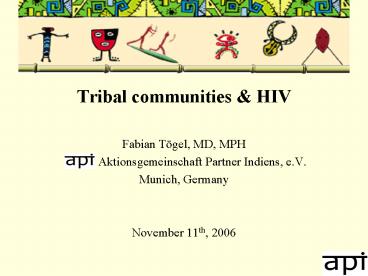Tribal communities - PowerPoint PPT Presentation
1 / 17
Title:
Tribal communities
Description:
Tribal communities & HIV. Fabian T gel, MD, MPH. Aktionsgemeinschaft Partner Indiens, e.V. ... 'Half of the world's indigenous people live in India' (89 million, ... – PowerPoint PPT presentation
Number of Views:14310
Avg rating:5.0/5.0
Title: Tribal communities
1
- Tribal communities HIV
- Fabian Tögel, MD, MPH
- Aktionsgemeinschaft Partner Indiens,
e.V. - Munich, Germany
- November 11th, 2006
2
- Half of the worlds indigenous people live in
India (89 million, equivalent to the current
population of the State of Bihar or the
Philippines) - Tribal identity differs from caste identity in
terms of language, social organization,
religious affiliation, economic patterns,
geographic location and self-identification - Primitive Tribes - low literacy
- - pre-agricultural technology
- - stagnant/diminishing population
3
- 8.1 of the population (89 million)
- Protected under constitutional schedules 5th
(areas in Central India with gt50 tribal
population) and 6th (in the Northeast) - Tribal sub-plans under Integrated Tribal
Development Agency (ITDA) - Article 46 (promotion of interests, protection
from exploitation), Article 47 (improve
standard of living, promote public health) - National Health Policy, 2002 (equitable access
to health services) with reference to tribals
4
Social Assessment of HIV/AIDS among Tribal People
in India
- A report submitted to the National AIDS Control
Programme Phase 3 (NACP-III) Planning Team, New
Delhi (May 2006) - Data collection from one district each in Andhra
Pradesh, Chhattisgarh, Maharashtra, Manipur, and
West Bengal - Review of social dimensions of other project
preparation studies - Consultations with tribal stakeholders and other
participating agencies
5
Key findings of Social Assessment
- Low awareness and knowledge of HIV/AIDS and STIs
- Wide variation in sexual and marital practices
- Very low access to modern health facilities
(especially women face social, physical and
economic barriers to seeking healthcare) - High use of traditional healers or unqualified
practitioners - High vulnerability among youth and those who come
in contact with non-tribal populations (eg.
migrants, women engaging in sex work)
6
Contact with high-risk groups (HRGs)
- Women Truckers, contractors, tourists, defence
personnel - Men CSW during migration
- Acting as HRGs
- CSW, MSM or IDU (in Northeast)
- Other ways of acquiring HIV
- Pre- and extramarital unprotected sex, unsafe
injection and tattooing practices
7
- NACP-3 Tribal Strategy Action Plan 2006-2011
- Classification of districts based on prevalence
Level A High prevalence district Level B
Concentrated epidemic Level C Vulnerable
population Level D Low prevalence, low/unknown
vulnerability Accordingly, the district will see
varying numbers of services including ICT, PPTCT,
STI/OI care, ART, presence of link workers.
8
Implementation of Tribal Action Plan
- Mapping of vulnerable populations in
collaboration with the Integrated Tribal
Development Authorities (IDTAs) - Translation of IEC material by Tribal Research
Institutes for behavior change communication,
condom promotion referral to ICTC and ART
services - Compensation for travel and related expenses
- Targeted interventions for migrant workers
- Involvement of CBOs/NGOs
9
Challenges
- Mainstreaming Collaboration with the Ministry of
Tribal Affairs, Ministry of Social Justice
Empowerment, Ministry of Human Resource
Development (Education) - Integration into National Rural Health Mission
(NRHM), Reproductive Child Health Phase 2
(RCH-2), Revised National TB Control Programm
(RNTCP)
10
NGO initiatives to prevent HIV among tribals in
Jhabua district, Madhya Pradesh
- District profile
- Borders with Rajasthan, Gujarat, Maharashtra
- Population 1.4 million (2001 Census)
- Tribal population gt 85 (1.2 million belonging
to Bhil tribe) - Below poverty line 47
- Literacy 37 (4 among women lowest literacy
in the country in the 1991 Census) - Lowest Human Development Index of all 45
districts in the State (2002) - Out-migration 65 on average during last decade
- Low HIV/AIDS awareness (WHARF survey during July
2004 workshop)
11
Current scenario of Madhya Pradesh (since
inception 2001), MPSACS
Jhabua district with the VCT centers at
Jhabua, Alirajpur and Jeevan Jyoti
Hospital/Meghnagar
12
Jhabua district HIV prevention program
Germany
WHARF Mumbai/Boston
Funding
Technical support
Jeevan Jyoti Health Service Society, Jhabua
(operating a 100-bed mission hospital)
Medical supervisor
Project Manager
Counselors
Patients
Coordination with district administration higher
secondary and college HIV education programme
Services in 3 voluntary counseling testing
centres across the district (Jhabua, Alirajpur,
Meghnagar)
Coordination of 582 Self-help groups in 180
villages across the district IEC activities
including linkage with voluntary counseling
testing centres
Clients
Referral
Government institutions Community Health
Centres ART Centres in Indore/ Ahmedabad
13
Voluntary Counseling and Testing at Three Centres
in Jhabua district
14
Characteristics of 68 clients tested in the
period of August through October 2006
Clients largely from tribal community
More than 2/3 of clients were women
Almost half of clients were illiterate
40 of clients had TB, 45 had an STI
15
Scaling up the programme
- Since prevalence (1.88) still low
- Increase service uptake through direct referral
from village self-help groups, TB and antenatal
care programs, other NGOs - Collaborate with medical officers on STI care
- Establish two additional VCT centres at Pelawad
(Northeast corner of the district) and Pitol
(truckers stop at the border with Gujarat) - Extension into other districts with NGO
presence Ratlam, Neemuch, Mandsaur (prevalence
3!) - Establish linkage with ART Centres at Indore and
Ahmedabad
16
Recommendations
- Rally for local support, community involvement
- Public-private partnership direct Government
support under NACP-3 - Support from abroad (financial, experts)
- Large scale-funding to conduct
behavioral studies, targeted interventions,
condom promotion - Engage stakeholders in discussion on
circumcision and stigma reduction - Formalize linkages with RNTCP, NRHM, RCH-2
17
Thank you!

